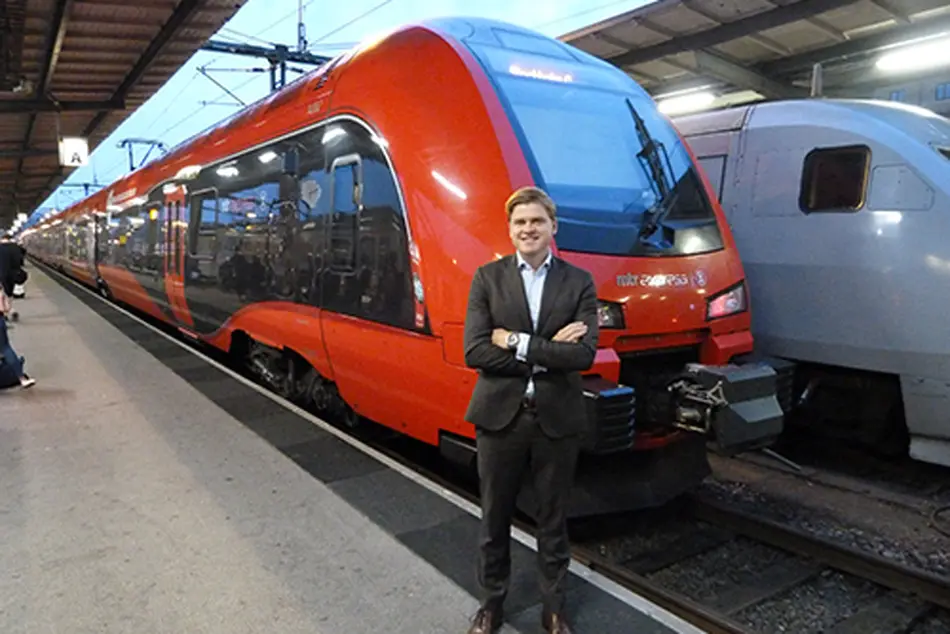MTR Express takes on SJ in Sweden

David Briginshaw joined Mats Johannesson, the new CEO of MTR Express, for a trip from Gothenburg to Stockholm on MTR’s first open-access inter-city operation on August 29 where he saw first-hand how the service is performing.
MOST IRJ interviews with senior railway managers are conducted in offices or at conferences, so it made a pleasant change to be able to interview the new CEO of MTR Express, Mr Mats Johannesson, during a journey on one of his trains from Gothenburg to Stockholm, even if it did mean a very early start to make the 06.00 departure.
The train was standing next to an SJ X2000 train highlighting the fact that MTR Express is operating in direct competition with Sweden’s national passenger operator SJ on the 455km Gothenburg - Stockholm corridor, which Johannesson described as SJ’s “cash cow.”
Mats Johannesson 4The current modal split on this important route between Sweden’s two largest cities is 50% road transport, 30% rail and 20% air. Despite concessioning of some regional services to independent operators and limited open access competition, SJ remains the dominant player in the Swedish main line passenger rail market with close to a 90% market share. Nevertheless MTR is keen to change this.
It took just 17 months from ordering a fleet of six 200km/h Flirt EMUs from Stadler, Switzerland, in November 2013 to the start of operation in March 2015. The contract was worth SKr 700m ($US 87.9m) and the trains are being leased through Credit Suisse. “Norwegian State Railways (NSB) had ordered 50 trains from Stadler so we were able to add our trains on to that contract,” Johannesson explains.
MTR had expected to be able to add its services to the SJ online booking system. “We set up a project team with SJ to do this but then a new management team arrived at SJ and we were kicked out six months before the start of the service,” says Mr Peter Viinapuu, CEO of MTR Nordic. This was a significant setback for MTR Express as people are familiar with the SJ website for booking rail travel in Sweden. Johannesson says Norway will not make the same mistake when it opens its passenger rail market to competition as the NSB train booking website will be separated from the national operator.
“This forced us to develop our own website and app in a good way,” says Johannesson. Indeed, the MTR Express website was voted the best in Sweden in 2016. MTR Express puts a lot of effort into marketing its brand and services. Its trains have clear messages on each side promoting the lowest fares, for example. Indeed, MTR’s philosophy is to provide a high-quality, punctual service at lower fares than those offered by SJ.
“We are trying to do something very different to get a good response from our customers,” Johannesson says. “Our biggest challenge is to make more people aware of the brand. We measure awareness weekly, and already 40% of people we ask mention MTR spontaneously. We are quite well-known among people in the 18-30 age bracket, but these people are quite price-sensitive. We want to get more people to buy higher-value tickets and we are trying to attract more business travellers.”
First class
MTR Express offers first-class travel, and while seats are identical to those in standard class, passengers are provided with free drinks, a meal and a newspaper during the trip, as well as access to the MTR Express lounge at Stockholm Central station.
Johannesson admits that awareness of MTR Express among travellers decreases as age increases, so more work needs to be done to reach older people.
Johannesson says that MTR Express is more punctual than its rail and air competitors on the Stockholm - Gothenburg route. “Our punctuality is 12-13% better than SJ’s,” he says. “Stadler maintains our trains, and we have never had to cancel a service because of a technical problem. Our availability is 99.5%. Punctuality is the main driver of customer satisfaction.” Johannesson says this is currently at 90% on MTR Express while customer on-board experience is rated at 95%.
“We have a very different company culture from SJ,” Johannesson continues. “Our staff is very customer-focussed. Our service attendants come from airlines, hotels and restaurants while some are first-timers.”
MTR Express currently employs 120 operating personnel of whom 30 are drivers and 60 on-board service attendants. MTR has taken the initiative to start training drivers to address a national shortage of train drivers. “A lot of drivers are retiring and there is a lack of training for new drivers,” Johannesson explains. The first 30 trainees are now going through a 40-week course.
Another problem MTR Express faced when it started was that its first train of the day was allocated a path which it judged to be too early in the morning. This was subsequently changed through pressure from MTR Express. “The track access path application process is not mature yet,” Johannesson says, “although it is quite fun to be the driver of this development.”
Stepped-up
MTR Express currently operates 100 departures per week, with six trains in each direction on weekdays. This will be stepped up to 110 departures per week with the start of the 2018 timetable in December. MTR Express will also add a fourth intermediate stop at Alingsås and will cut journey times by 12 minutes following approval to operate at a maximum speed of 200km/h. “Our journey times are 22-23 minutes longer than those of SJ because our trains do not tilt through curves, although our trains have better acceleration than X2000 so we can recover better from delays,” Johannesson says.
Traffic has been increasing steadily from 276,000 journeys in 2015, to 568,000 last year and an estimated 739,000 this year. MTR Express’ annual revenue was around SKr 250m last year and it made a loss of SKr 90m which Johannesson says was according to budget. “We have doubled annual revenue each year since we started, and we have an occupancy rate of around 65% which is quite OK,” he says. “2017 will also end in red numbers, but we are heading and planning for black numbers in 2018.”
As for the future, Johannesson says MTR Express needs to get into profit before taking the next step. “MTR’s philosophy is not to rush, but to build stability and profitability. But we are not here to operate just one route - we are sub-scale at the moment. But all the work we have done to build brand awareness we will get for free when we expand. We want to be the best train operator in the world.”
Overseas expansion helps MTR achieve four-fold revenue growth in 10 years
MTR Corporation was set up in 1975 by the Hong Kong government as the Mass Transit Railway Corporation to construct and operate a metro network. MTR became a limited company in June 2000 after Hong Kong’s special administrative region government sold 23% of its issued share capital to private investors in an initial public offering. MTR Corporation shares were listed on the Stock Exchange of Hong Kong in October 2000.
In 2007 the government decided to merge Kowloon-Canton Railway Corporation with MTR to create a single railway in Hong Kong. The merged network comprises 10 lines as well as the Tuen Mun light rail network and the Airport Express line. MTR also operates a bus network in Hong Kong.
MTR has expanded into mainland China and now operates metro lines 4, 14 and 16 in Beijing, Longhua Line 4 in Shenzhen and Hangzhou’s metro Line 1.
In Britain, MTR runs TfL Rail in London in preparation for operating the entire Crossrail network as the Elizabeth Line in 2018, and has just taken over the South Western rail franchise in partnership with First Group.
In Australia, MTR is a 60% shareholder in the consortium which operates the Melbourne Metro commuter rail network. In September 2014 the Northwest Rapid Transit Consortium, of which MTR is a shareholder, was awarded the operation, trains and systems public-private partnership contract for the Sydney Metro Northwest project.
In Sweden, MTR holds concessions to operate the Stockholm metro and commuter rail networks and operates MTR Express.
MTR has a substantial property development and management business along with a station commercial business in Hong Kong. The company also provides consultancy services in cities in Asia, Australia and the Middle East.
MTR’s expansion has seen a more than four-fold increase in annual revenue during the last 10 years from $HK 10.7bn ($US 1.37bn) in 2007 to $HK 45.2bn in 2016, while net profitability fluctuated during the same period, and dropped from $HK 15.8bn in 2014 to $HK 10.3bn last year. However, 2017 first half results show a substantial upturn with revenue up from $HK 21.3bn in the first of 2016 to $HK 30bn for the same period this year, while net profit jumped from $HK 5.2bn to $HK 7.5bn.

